Choose your sales office
PRODUCT
ELIchrom glabrata
Rapid test for the identification of Candida glabrata.
ELIchrom glabrata is a fast unitary test for the rapid identification of Candida glabrata colonies.
- Cost-effective routine laboratory test
- Easy and ready-to-use
- High sensitivity and specificity
- Fast results for clinicians (20 minutes)
- Simple colorimetric reaction, without expert interpretation
| Reference | Name | Quantity |
| 44506 | ELIchrom glabrata | 40 tests |

Image Gallery
Benefits
Intended use
Candidas are usually commensal yeasts of the digestive and urogenital mucosas. They become pathogenic only when favorable conditions arise in the host. Studies show that C. glabrata is the second most commonly encountered yeast in humans and its pathogenic nature is no longer disputed: C. glabrata is responsible for 10 to 25% of all the candidemias. Moreover, C. glabrata is generally less sensitive to azole derivatives, with certain isolates from patients treated with fluconazole or ketoconazole appearing to be resistant to virtually all the azole derivatives. The isolation and rapid identification of C. glabrata is thus essential to determine the correct therapeutic treatment. Traditionally, biochemical tests are used in the identification of C. glabrata. The disadvantage of the carbon auxanogram and the zymogram is that there is a long 24 to 48 hours wait before the tests can be read. C. glabrata can be identified more quickly with systems based upon the detection of preformed enzymes that use chromogenic substrates or alternatively, that are based upon the assimilation of trehalose. ELIchromglabrata is a rapid C. glabrata identification test based upon the detection of trehalase.
Principle
C. glabrata is able, under certain conditions, to rapidly hydrolyze trehalose into glucose. The detection of glucose production (by a revelator, which contains oxidase glucose, peroxidase and a chromogenic substrate) can therefore be used to positively identify this species. However, in addition to the trehalose test, two controls must also be carried out:
- A maltose control is necessary because certain C. tropicalis isolates can also degrade trehalose, but unlikeC. glabrata they also assimilate maltose.
- A control is carried out in the absence of monosaccharide (reagent base medium control). This is necessary because of the presence of glucose in isolation media.
Simple protocol
- Add 100 µL of sterile distilled water to a haemolysis tube.
- Homogenize the colonies in the tube in order that the suspension density is equivalent to point 5 in the Mc Farland range (3-4 colonies if the culture has been carried out on Sabouraud medium and 3-8 colonies, according to the colonies size, if the culture has been carried out on a chromogenic medium).
- With a micropipette add 25 µL of the prepared yeast suspension to each blue spot in the T, M and B wells.
- Leave the test to incubate for 10 minutes at room temperature.
- With a micropipette add 25 µL of the reagent to each of the T, M and B wells.
- Incubate the test for 5 to 10 minutes at room temperature.
- Read the test results.
Easy-to-read and easy-to-interpret results
- Positive + : Appearance of a more or less dark orange coloration
- Negative – : Absence of any coloration
| Results | Conclusion | ||
| WELL T (Trehalose) | WELL M (Maltose) | WELL B (Base Medium) | |
| + | – | – | C. glabrata. |
| – | – | – | Non C. glabrata yeast. Continue the identification. |
| + | + | – | |
| – | + | – | |
| + | + | + | Non interpretable. Repeat the tests by carefully sampling the yeast without moving the agar. |
Reagents and Material
- REAG: Vial of lyophilized reagent (to be reconstituted with 1.3 mL of sterile distilled water)
- TEST CARD: Test cards containing 12 wells, 3 of which are for identification:
- T wells contain base medium and trehalose
- M wells contain base medium and maltose
- B wells contain base medium
Stability and Storage
- Reagents stored at 2-8°C, in their original state, are stable up to the expiry date indicated on the box. They must not be frozen. The results of the stability study indicate that the product has a stability of 12 months at 2-8°C from its manufacture.
- It was also demonstrated that, after reconstitution, the REAG is stable 4 weeks at ambient temperature and 2 months between 2°-8°C.
- The shelf life of the reconstituted REAG may be extended to 6 months by freezing it (-20°C) in the form of 75 µL aliquots immediately after reconstitution.
Performance
The evaluation results for ELIchrom glabrata are listed below depending upon the isolation medium used.
| Medium | Sensitivity | Specificity |
| Candida ID | 97.9% | 98% |
| CandiSelect | 97.9% | 97.6% |
| Sabouraud | 97.9% | 98.8% |
| CHROMagar candida | 93.8% | 98.8% |
Material required but not provided
- Automatic pipette(s) with a pipetting volume adapted to the volume that will be measured
- Hemolysis tubes
- Sterile distilled water
- Pasteur pipette or wire loop
- Contaminated waste container
Manufacturer: ELITech Microbio.
Product(s) intended for healthcare professionals.
Read the instructions on the label and/or instructions for use of the product(s).
![]()
Let us help you
For general inquiries, please use the links to the right. Click Contact to complete a brief online form, or click Support for general phone and email information. Someone will be in touch with you soon.


![elichrom_glabrata_principle[1]](http://www.elitechgroup.com/wp-content/uploads/2015/01/elichrom_glabrata_principle1.jpg)
![elichrom_glabrata_results[1]](http://www.elitechgroup.com/wp-content/uploads/2015/01/elichrom_glabrata_results1.jpg)